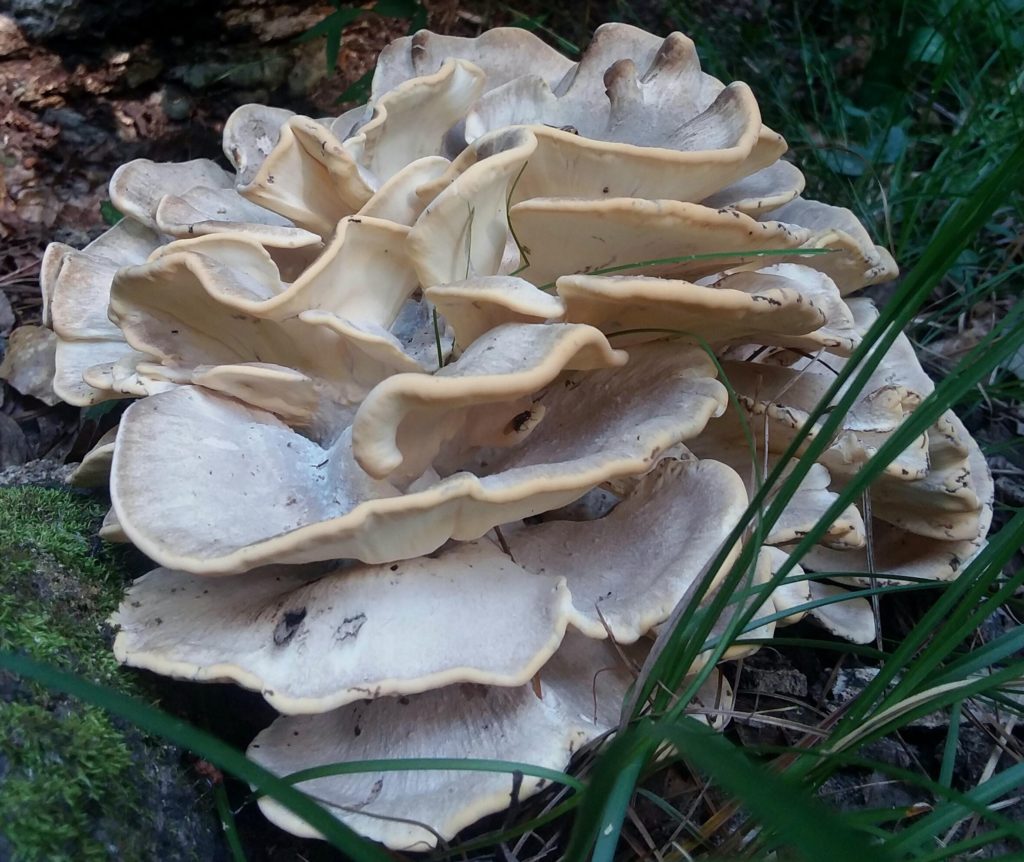Meripilus sumstinei[i] is a large, multi-capped polypore that is interesting largely because it tends to be mixed up with other species. M. sumstinei is edible[ii], but few people enjoy it. If it has medicinal value, that value is yet to be researched or described. But the species is a close look-alike for Grifola frondosa (maitake or hen-of-the-woods), a choice edible famed for its medicinal value. Several other species, most of them also edible, also resemble this species to greater or lesser degrees. The problem is not so much one of accidental poisoning through misidentification (although foragers should use caution; dangerous mistakes are always possible) as the risk of wasted time and effort—and the risk of a mushroom removed from its environment for nothing.
Perhaps in keeping with the potential for ID confusion, M. sumstinei is also the center of a mixed-up knot of names. Part of the problem is that the species, which has an exclusively North American distribution, has a close relative in Europe, M. giganteus, and many authorities mistakenly apply the giganteus name to both. Some of the same common names, such as “black-staining polypore,” also apply to both.
Also, M. sumstinei’s look-alike, hen-of-the-woods, is often confused with chicken-of-the-woods solely on the basis of their names—the two do not closely resemble each other. Apparently as a joke, “rooster-of-the-woods” has been proposed as a common name for M. sumstinei, creating a whole flock of fungal poultry for mycophile tongues to trip over. The name seems to be catching on, as it appears on several websites.

My name is Austin Collins.
I've dedicated my life to Mushrooms.
I believe Mushrooms are the best kept secret when it comes to health and well being.
For that reason, I would like to share a company with you that in my opinion makes the best mushroom products on the market.
The company is called Noomadic Herbals, my favorite supplement they make is called "Mushroom Total".
I take their products every day and they have helped me think better and have more energy. Give them a try.
-Austin
Meripilus Sumstinei Identification and Description
Cap: Each cap is medium-sized, fan-shaped, whitish when young and turning brown with age—bruising black when touched. The interior flesh is white and slightly stringy. Multiple caps grow in an irregular rosette from the same branched stem.
Gills: No gills—the spores are released from pores. Because the pores are very small, the pore surface looks very smooth. It is white to tan, and bruises brown or black when touched.
Stem: Tough, short, often off-center, white at first and darkening to brown with age.
Smell: Mildly pleasant
Taste: Mild to slightly acidic.
Spores: Smooth, elliptical to round
Spore color: White
Edibility: Edible, but not popular
Habitat: Eats living or dead wood, mostly oaks and other hardwoods, though it has been reported on Douglas-fir. The fungus fruits from the base of its tree in the summer and fall.
Differentiating M. sumstinei from its several look-alikes in North America is not actually difficult, since it is the only one that bruises black when handled. The black bruising also adds to the perceived unpalatablility of the species; few people like to eat black food.
Meripilus Sumstinei Look-alikes
The main look-alikes of M. sumstinei are Grifola frondosa (maitake, or hen-of-the woods), Bonarzewia berkeleyi (Berkeley’s polypore), and Sparassis spatulata (cauliflower mushroom)[iii]. None are toxic, and of the group, M. sumstinei is the only one that bruises black. There are other differences.
- frondosa has small caps and the pore surface is grayish lavender when young, whereas M. sumstinei has larger caps and the pore surface is white when young.
- berkeleyi has large, thick, cream-colored caps with very large pores, especially close to the stem. M. sumstinei has thinner, smaller caps that are white to brown, and its pores are unusually small—the pore surface is notably smooth.
Sparassis spatulata has long, thin, folded, ribbonlike caps; the whole fruiting body resembles a giant carnation rather more than a cauliflower. M. sumstinei lacks the distinctive ribbonlike look.
- gigantea does reportedly look very like its American cousin, and does stain black, but there is little risk of confusion unless somebody plants some in North America and it escapes.
Meripilus Sumstinei Benefits
- sumstinei is edible, at least when young, but it is not popular. A few people do enjoy it, especially for making broth or meat substitute[iv]. Its nutritional profile is not known. It has no known medicinal application (yet).
Meripilus Sumstinei Dosage
Dosage is not an issue, since this species is not used in medicine.
Meripilus Sumstinei Toxicity, Safety & Side Effects
While M. sumstinei is generally considered edible, its close relative, M. giganteus, also reportedly edible, sometimes causes gastrointestinal problems[v]. It’s likely M. sumstinei can have a similar effect.
References:
[i] Kuo, M. (2010). Meripilus sumstinei.
[ii] Black-staining Polypore: Meripilus sumstinei (Formerly, M. giganteus). Missouri Department of Conservation.
[iii] Black-staining Polypore: Meripilus sumstinei (Formerly, M. giganteus).
[iv] Rooster of the Woods. Inside the Outside website, accessed March 31, 2020.
[v] Meripilus giganteus (Pers.) P. Karst. – Giant Polypore. First Nature website, accessed March 31, 2020.




Can a black staining polypore be dried and used as “decoration”?
I mean, yes. You can do this without almost anything if it’s preserved correctly.
And what is the correct method to preserve a Berkeley polypore mushroom.
I ate a little bit of it and had gas and mild nausea. It is not over yet, so am not sure how I will end up :0). Would not recommend it.
did you cook it, or eat it raw?
I find this mushroom has a rich beefy flavor though the tough texture makes it hard to eat as is except the tips of the freshest finds. I prefer to use it to make a rich mushroom stock or to add flavor to other dishes. Chop and sauté the shroom with some onions then add plenty of water and simmer for 2-8 hours with any other good stock things like garlic carrots celery thyme peppercorn bay parsley, etc. strain then use for soup or freeze for later.
Thanks for sharing! Very cool!
It’s early August here in Northern Virginia. Found one of these while walking in the woods and was stumped about this one’s identity.
The clump was huge, about 1 foot square, mostly creamy white with grayish rings, with each “leaf” resembling a huge, fleshy, rubbery Turkey Tail. The pores were not very noticeable and the underside felt smooth. Nearby there were very young versions noticeable which looked nothing like this older one but which I now know are better for eating.
I cut off about a 1/2 lb to try it out. It was located at the base of a fallen oak.
By the time I got home 1/2 hour later, the cut pieces were well marked all over with black and brown colored bruises where I had grabbed them while cutting them.
It’s very tough and fibrous, as noted in the article, except for the very edges. It smells very good, like typical edible mushrooms you find or get at the grocery storr.
It made a good mushroom, clear, golden brown broth. The tips, sliced as thin ribbons or in a matchstick size, do make a fine addition to whatever soup, pasta or Asian dish you’ll be using that broth for. I will try blending, cooking in water then and straining to see if that gives a heartier soup base next time.
Thanks for this article which gave me the confirmation and confidence I needed to use these black staining polypores.
I just found one, or so I think. My first thought was a hen. Then a Blackie. Then a hen again. Now I’ve settled back on black. I’ll let you know after the pieces are done sautéing in this butter! Love your site and your enthusiasm for fungi and the outdoors. We are unfortunately fewer and fewer.